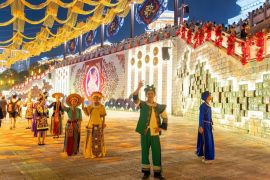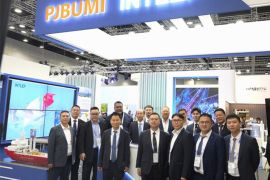"Taicang was also the home port of the famous Chinese explorer Zheng He, the great navigator of the Ming Dynasty," Vice Director of the Taicang Port Niu Jian Ping said.Jakarta (ANTARA News) - Taicang, a city under the jurisdiction of the City of Suzhou in Jiangsu Province, has benefited for centuries from the exsistence of the Yangtze River.
The city, around 50 km northwest of Shanghai, had served as an important port and business hub within the ancient Silk Road.
Located in the alluvial plain of the Yangtze River delta, Taicang had been called the Great Granary because in the ancient time, Chinese emperors built granaries on the land to store grain or rice.
Being asked on how big the Yangtze River is, Chinese people will say that you will not be able to see the other side of it.
The Asias longest river, believed to be the cradle of Chinese ancient civilizations, is astonishingly wide that the sheer size of the river alone allows tankers, cargo ships or large haul sealiners to cruise.
"In my country, this will be an ocean, not a river," a Filipino journalist Reynaldo Galupo said after witnesing dozens of sealiners sailing of Yangtze River in Taicang Port.
The largest river port in China has recently welcomed fifteen ASEAN journalists who were invited to a Media Journey of the 21st Maritime Silk Road 2016, organized by the China Report and ASEAN-China Centre.
The journalists had an opportunity to visit several destinations in China along the ancient Silk Road to witness the history and recent development in the strategic regions within the 21st Century Maritime Silk Road or shortly known as the One Belt One Road.
The Belt and Road innitiative was first proposed by Chinese leader Xi Jinping during a speech to the Indonesian Parliament in October 2013.
Taicang Port in eastern-center coastal Province of Jiangsu becomes one of the starting points of the glorious Chineses ancient Silk Road from which China aims to increase investment and foster collaboration across the ancient trade route.
Home Port of Chinese Great Explorer
"Taicang was also the home port of the famous Chinese explorer Zheng He, the great navigator of the Ming Dynasty," Vice Director of the Taicang Port Niu Jian Ping after receiving the ASEAN journalists.
Zheng He began his seven great voyages from Taicang port, which is located at the south bank of the Yangtze River, as the east door of Jiangsu and the back garden of Shanghai.
Zheng Hes main ship, based on the historical record from an ancient shipyard in Nanjing, the capital of Jiangsu Province, measured 138 meter long and 56 meter wide, dwarfing the ship of Spanish explorer Columbus, which was one fourth the size of Hes ship.
Abundant storages, excellent harbour and advanced technologies in ship manufacturing had helped Zheng Hes explorations around 600 years ago.
The Chinese muslim great navigator with his grand fleet, consisting of 260 ships, departed from Taicang Port to Brunei Darussalam, Thailand, Java and several southasian countries up to far west through the Indian Ocean reaching India, the Horn of Africa and Arabian land.
A replica of Zheng Hes ship and some artifacts from the grand fleet are displayed for public in the Zheng He Memorial Park in Nanjing.
Golden Waterway of Yangtze
As a hub at the estuary of the Yangtze River, Taicang City has a coastline of 38.8 km, of which the deep-water port is 25 km long with the fairway depth of 12.5m to accommodate ships up to 200,000 tons.
Nowadays, the face of the ancient port has transformed into a modern and largest container port in the Yangtze River.
Entering the gate, thousands of containers are orderly piled up along the port.
Rows of red-painted onshore heavy-lift cranes stand ready waiting ships to arrive while the others are loading the steel containers to the queuing trucks.
The Taicang port is nationally recognized as an artery port for container transportation at the north wing of the Shanghai International Navigation Center, a hub for transportation by river and sea.
Consisting of 78 berths of various sizes, including 34 berths above 10,000 tonnage level and 10 berths for containers, Taicang Port was designed to have a throughput capacity of 130 million tons and 4.35 million TEUs.
It became the first river port of China which managed in line with seaport measures as well as the port with the largest number of non-stop vessel along the Yangtze River.
"Last year we handled 3.75 million of TEUs and 200.5 million tons of cargo," Niu Jian Ping said.
As of the end of 2015, Taicang Port had 177 shipping lanes including 20 near-sea shipping lanes to neighboring countries such as Japan and Taiwan.
In early 2016, Taicang Port opened its first shipping lane to the Southeast Asian countries to Thailand and Vietnam to explore more cargo potential in the region.
"Within the One Belt One Road innitiative, we want to seek more cargo potential to the Southeast Asian countries," Niu said.
Taicang Development Zone
Around half a million Taicangs population are now aiming to take the lead in realizing the modernization in the land of 810 square kilometers along the golden waterway of Yangtze River.
Since the establishment of the Taicang Port Economic and Technological Development Zone, a 261.8 square km industry cluster, in 2002 Taicang has taken shape into an industrial city with its GDP frequently listed among the top ten rankings of the 100 most developed county-level cities in China.
The industry cluster has become home for multi-national enterprises while petrochemical, electronics and energy are three pillar industries of the development zone.
The zone also houses wind and solar power equipment manufacturers, and a large-scale port equipment manufacturer such as Rainbow Cargotech Industries, a China-Finland joint venture.
"We produce around 100 onshore and offcshore cranes per year, with Vietnam and Indonesia are our biggest costumers in the Asian Market," General Manager Assistant of Rainbow Cargotec Industries Victor Wang said.
Last year, the company sold 22 cranes to Indonesian buyers with each crane costs around 1.5 million Euro.
Deputy Director of Administrative Committee of Taicang Port Economic and Technological Development Zone Zou Jiahong said that the Belt and Road innitiative offers great opportunity of cooperation and investment between China and ASEAN.
"The zone is located near ocean and it will be great to have more cooperation with the Southeast Asian countries in the future," Zou said.
The statistics show that in the 25 years of China-ASEAN dialogue relations, the bilateral trade volume between the two regions increased from 7.96 billion US Dollar in 1991 to 472 billion US Dollar in 2015
Flaunting its plummage in Taicang, China is seeking to revive the ancient trade route to build cooperations and mutual development with countries located along the ancient trade route just like what the Great Zheng He had done in six centuries ago.(*)
Reporter: Aditya E.S. Wicaksono
Editor: Heru Purwanto
Copyright © ANTARA 2016











